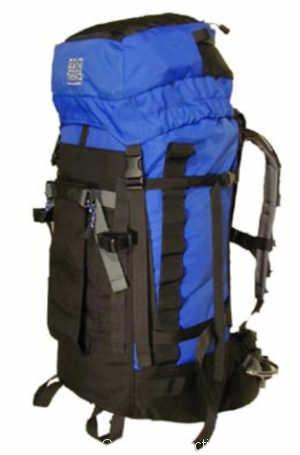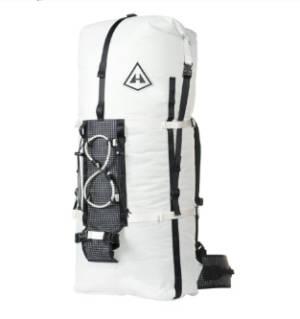
Winter backpacking backpacks are more specialized than regular three season backpacks, with a stronger emphasis on heavier weight loads, external attachment points, and durability for carrying bulky gear with sharp points like snowshoes, skis, ice axes, and crampons. They also favor more pockets and the ability to access and put away gear quickly, so you can avoid standing around between gear transitions and getting cold. Pack volumes can vary anywhere from a minimum of 50L to 100L, with 70L usually being the sweet spot for a comfortable weekend length trip.
Here are our picks for the top 10 best winter backpacking packs:
| Make / Model | Weight | Floating Lid | Crampon Pocket | Hip Belt Loops | Ski Carry | Price (USD) |
|---|---|---|---|---|---|---|
| Alpine Luddites Alpine Machine 70 L | 48 oz | Y | - | Y | Option | $650 |
| Black Diamond Mission 75 L | 64 oz | Y | Y | Y | - | $240 |
| Cold Cold World Chaos 66 L | 60 oz | Y | Y | Y | Y | $245 |
| Exped Lightning 60 L | 41 oz | - | - | - | Y | $229 |
| Gregory Denali 75 L | 72 oz | Y | - | Y | - | $360 |
| Hyperlite Mountain Gear Ice Pack 70 L | 37 oz | - | Y | Y | Option | $380 |
| Mountain Hardwear South Col 70 L | 59 oz | Y | Y | Y | - | $300 |
| Osprey Mutant 52 L | 55 oz | Y | - | Y | Y | $200 |
| The North Face Cobra 60 L | 57 oz | Y | Y | Y | Y | $250 |
| The North Face Phantom 50 L | 40 oz | Y | - | Y | Y | $190 |
1. The North Face Cobra 60 L
2. Cold Cold World Chaos 66 L
Check for the latest price at:
Cold Cold World
3. Gregory Denali 75 L
4. Hyperlite Mountain Gear 4400 Ice Pack (70 L)
Check for the latest price at:
Hyperlite Mountain Gear
5. Mountain Hardwear SouthCol OutDry 70 L
Check for the latest price at:
Mountain Hardwear | Moosejaw | Amazon
6. Osprey Mutant 52 L
7. The North Face Phantom 50 L
Check for the latest price at:
Moosejaw
8. Black Diamond Mission 75 L
Check for the latest price at:
Black Diamond | Amazon
9. Exped Lightning 60 L
10. Alpine Luddites Alpine Machine 70 L
Check for the latest price at:
Alpine Luddites
HOW TO CHOOSE A WINTER BACKPACK
Backpacks tailored for winter use have a different feature set than most 3 season packs. What follows are the features that I've found most useful for overnight and multi-day winter trips in mountainous terrain. While I think these translate fairly broadly across winter locales, you need to be the judge on the features you believe are most relevant for your needs.
Volume and Weight
If you mostly plan on doing overnight or weekend-length winter backpacking trips, you'll probably want a pack that has 65-85 liters of internal capacity. The sweet spot is about 70 liters, but you might be able to shave that down as low as 50-55 liters if you carry less gear or need less insulation. Try to get a pack that has adequate compression so you can shrink its volume if not needed, while keeping the weight of an empty pack under 5 pounds. Pack and gear weight are even more important in winter than the rest of the year, because you'll be wearing and carrying a lot more of it.
External Attachment Points
Winter packs need to have a multitude of external attachment points to carry sharp, pointy, or bulky gear that won't fit inside the main storage areas of a backpack. The most useful external attachment points include compression straps, daisy chains, hip belt webbing or gear loops, and ice axe loops with shaft holders.
Compression Straps
Compression straps serve two purposes: to help compress a puffy load and bring the weight closer to your core muscles where it can be carried more easily; and to attach sleeping pads, snowshoes, avalanche shovels, or skis to the sides of your pack instead of the front, so that the load doesn't pull you backwards and off-balance.
When choosing a backpack, try to find ones that have two or three tiers of compression straps that run horizontally across the sides of the packs. The compression straps should be adjustable and easy to undo while wearing gloves so you can slide snowshoes under them. Avoid packs that have compression straps that zig zag back and forth on the backpack using one strap to save weight. These are very difficult to use.
Daisy Chains
Daisy chains are often sewn onto winter packs and can be used to lash extra gear to the back or sides of the pack using canvas or velcro straps. They usually have many loops sewn into them that run the length of your pack from top to bottom.
Ice Axe Loops
There are two kinds of ice axes in this world – straight walking axes and curved climbing axes. If you need to carry a walking axe, look for a pack that has at least one ice axe loop at the base of the pack and a shaft holder, both off-center along the back of the pack. The shaft holder can be a simple cord lock like those found on many Osprey packs, or a more robust buckle. If you plan on carrying two climbing axes, look for packs with two ice axe loops and shaft keepers.
Hip Belt Webbing and Gear Loops
Some climbing oriented packs have canvas or plastic gear loops on the outside of the hip belt to clip climbing carabiners to. While not a substitute for a proper sit harness, these loops can be quite convenient to rack gear. Alternatively, you can clip insulated water bottle holders to them so you can drink when you are on the move and don't want to stop. Extra hip belt webbing serves the same purpose and is often better than having belt pockets that are too small for winter use.
Crampon Pockets
Crampon pockets are a very convenient and safe place to store crampons when you're not wearing them. Located on the side of the pack farthest away from you, they keep the crampon points away from your arms and legs, your head, and your gear where they can do real damage.
Floating Lids
It can be very helpful in winter to have a backpack that can expand in volume to carry more gear. One way to do this is to buy a pack with a floating lid, usually a top pocket that can detach from the main body of the pack but is still held down by 4 straps. Extra gear, say a coil of rope, can be sandwiched between the pocket and the top of your pack in this manner.
Backpack Pockets
Backpack pockets can be a two-way street in winter. While they can be useful for organization, they can also add a lot of unnecessary weight to a backpack. For example, having a backpack with a separate sleeping bag pocket is pretty useless, because your sleeping bag can just as easily be stored in one large main compartment without needing the extra fabric weight and zipper required for the additional pocket.
Accessory Pockets
Most of the hip belt pockets provided by manufacturers are simply too small to be of much use in winter, and there aren't enough of them to carry everything you might need for a winter hike, such as a camera, sun tan lotion, lip balm, headlamp, compass, map, altimeter, and a pencil or pen. Many hikers add accessory pockets to their packs to provide more external storage or they wear an additional fanny pack backwards to provide another pocket that can store spare gloves, hats, and food.
Check Out All of SectionHiker's Gear Guides!
- 10 Best Hiking Boots and Trail Shoes of 2018
- 10 Best Backpacking Tents of 2018
- 10 Best Backpacking Stoves of 2018
- 10 Best Backpacking Water Filters of 2018
- 10 Best Backpacking Sleeping Bags of 2018
- 10 Best Ultralight Backpacking Quilts of 2018
- 10 Best Backpacking Sleeping Pads of 2018
- 10 Best Backpacking Rain Jackets of 2018
- 10 Best Budget Backpacking Tents under $250
- 10 Best One Person Backpacking Tents of 2018
- 10 Best Ventilated Backpacks of 2018
- 10 Best Hiking Daypacks of 2018
- 10 Best Hiking Pants of 2018
- 10 Best Trekking Poles of 2018
The post 10 Best Winter Backpacking Packs of 2018 appeared first on Section Hikers Backpacking Blog.
from Section Hikers Backpacking Blog https://ift.tt/2q0JHql










No comments:
Post a Comment